The Heritage Trees - The University of Arizona's Roots
Many of the unique trees on the University of Arizona’s main campus are the oldest, the most stately, or are in some way connected with former faculty and University of Arizona heritage. Some were the first to be planted in Tucson or in the territory of Arizona. Others were collected through international travels by University of Arizona botanists. A few are the only specimens in Tucson. All of these trees embody our university's heritage and represent an important link to the University of Arizona's status as the only Land Grant institute in the Sonoran Desert. Below you'll find examples of trees desigated as University of Arizona Heritage trees, and the story behind their special status in the tree collection.
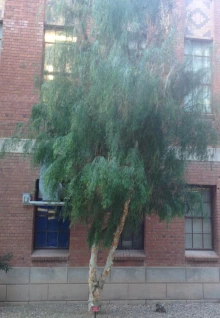
Scientific Name: Mariosousa willardiana | Common Name: Palo Blanco. | Geographic Origin: Sonora | Botanical Family: Fabaceae
Campus Location: This tree is tucked into "magic alley", a protected walkway south of Old Chem and north of the greenhouses.
Accession #: 1576
Special Status: Heritage Tree removed for construction in 2023.
Brief Description: The largest specimen of this species on campus, this tree was planted as a seedling by Warren Jones during his career as Professor of Landscape Architecture.
Brief Ethnobotany: The wood of this tree is used by the Seri Indians of northern Mexico for miscellaneous uses such as hut construction.
To learn more about this species, visit the species description page found here.
Available for Sponsorship: No

Scientific Name: Adansonia za | Common Name: Baobab | Geographic Origin: Africa | Botanical Family: Bombacaeae
Campus Location: This large tree graces the SW corner of the Administration Building.
Accession #:4386
Special Status: Heritage Tree recovering from 2011 freeze damage
Brief Description: It is the only flowering individual tree of its species in the US, according to a botanist at the Missouri Botanical Garden. Seeds brought from Madagascar were germinated in Virginia, and the seedling was subsequently held to 15 gallon size at the Arizona Sonora Desert Museum. It was installed by Warren Jones on campus around 1980. Designated a Great Tree of Arizona, 2002 and sponsored on behalf of the University of Arizona's Campus Arboretum's founding Director, Elizabeth Davison. Although severely damaged by record freezes in 2011, the tree is being carefully managed to restore growth and health.
To learn more about this species, visit the species description page found here.
Available for sponsorship: No

Scientific Name: Carnegiea gigantea | Common Name: saguaro | Geographic Origin: Deserts of Southwest United States | Botanical Family: Cactaceae
Campus Location: This special crested saguaro has stood on the grounds of Old Main for decades.
Accession # : 1304 (replaced with # 13136)
Special Status: Heritage Tree removed in 2014 due to internal rot. Replaced on the same campus site.
Brief Description: The cause of cresting is not fully explained, but whatever the stimulus, the growth point of the stem has switched from a geometric point, to a line, which folds and undulates as the crest expands. Cresting occurs naturally throughout the range of the Saguaro, and can be observed in many other cactus species. The original, iconic campus specimen was removed due to internal rot in 2014. However, thanks to the generosity of UA Campus Planning and Facilities Management, and with assistance from arborist Juan Barba and Associates, who located a new crested specimen, the UA Campus Arboretum has replaced this iconic plant with another beautiful and unique desert wonder. It is worth the effort to view it in person!
Brief Ethnobotany: Carnegiea gigantea is a member of Family Cactaceae. C. gigantea,or saguaro, is probably the most well know of the Cactaceae family due to its characteristically tall stature with many arms. The Apache Indians of the Southwest used the fruits of C. gigantea as a food source. The fruits can be made into large cakes by extracting the pulp from the fruits, forming the pulp into cakes, and drying it in the sun. The fruits can also be used to produce a juice drink and can be eaten raw. The Pima Indians make a drink from fermented pulp. The juice of the Saguaro cactus was used by the Seri Indians to treat rheumatism.
To learn more about this species, visit the species description page found here.
Available for Sponsorship: Yes
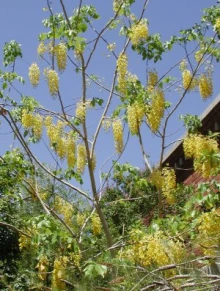
Scientific Name: Cassia fistula | Common Name: golden shower tree | Geographic Origin: India | Botanical Family: Fabaceae
Campus Location: West of Nugent
Accession # : 1539
Special Status: Living Heritage Tree
Brief Description: The only representative of the species in Tucson. This tree was planted by Warren Jones in the late 1980's. After a few cold damages, it has become large enough to withstand Tucson's winters. In summer, the tree drops its leaves, then produces chains of golden orchid-like flowers from its bare branches.
Brief Ethnobotany: Cassia fistula a member of the family Caesalpiniaceae is known for its characteristic bunches of beautiful yellow flowers and grows throughout India. The seeds from this tree are used in the treatment of many ailments. Traditionally, the seeds have been found useful in the treatment of skin disorders, swollen throat, biliousness, and jaundice. Presently, there have been investigations into the medicinal use for its anti-oxidant properties. It has been used in traditional Ayurvedic medicine for the treatment of cardiovascular diseases. The seed from the Cassia fistula tree appears to have anti-cancer and anti-bacterial properties in animal models.
To learn more about this species, vist the species description page found here.
Available for Sponsorship: Yes

Scientific Name: Ceiba acuminata | Common Name: silk cotton tree | Geographic Origin: South America | Botanical Family: Bombacaceae
Campus Location: West of Mathmatics
Accession # : 2476
Special Status: Living Heritage Tree
Brief Description: The only individual of its species on campus, this tree is located on the southwest corner of the Mathmatics building enjoying extra warm temperatures. With impressive trunk extrusions resembling (but not related to) rose thorns, silk cotton tree is also known for its impressive flowers. These appear in late May, and have long fringe-like stamens. This specimen was planted by Warren Jones in 1979, with help from Chuck Raetzman of Facilities Management.
Brief Ethnobotany: This plant, also know as the kapok tree, is in the Bombacaceae family, blooms at night, and is bat pollinated (by Leptonycteris spp.). The ceiba was a sacred Mayan plant named yaxche with profound symbolic significance, and was revered by priests and used in ceremonies. It is still Guatemala’s national tree. It is related to the more famous kapok species, Ceiba pentandra, whose fiber is used as a stuffing and oil absorbent, and contains isoflavones and glycosides that contribute to a myriad of effects on medical conditions such as high blood pressure, tumors, wounds, and cough. C. pentandra is also one of the admixtures (in addition to Chorisia insignis and Ficus insipida, see below) in ayahuasca preparations used by traditional healers in the healing ceremonies.
To learn more about this species, vist the species description page found here.
Available for Sponsorship: Yes
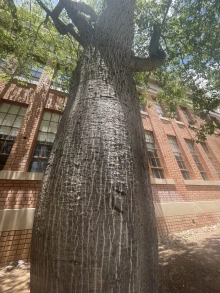
Scientific Name: Chorisia insignis | Common Name: floss silk tree | Geographic Origin: South America | Botanical Family: Bombacaceae
Campus Location: South of Engineering
Accession # : 1322
Special Status: Living Heritage Tree
Brief Description: This bizarre old tree was reportedly planted in late 1940's-early 50's, It delights students with its bulbous, thorny trunk year round and with its creamy orchid-like flowers each winter. It was designated a Great Tree of Arizona, 2003. A second individual was transplanted to the south side of Bio West, from a foothills location in 1984.
Brief Ethnobotany: Trees from the Chorisia genus produce a seed pod that contains a cottony substance which is used in South America as a stuffing for pillows, mattresses and toys. The inner bark of C. insignis is used to make cordage, and the tree itself is hollowed out to make dugout canoes, as per the LA County Arboretum.www.arboretum.org/arboretum/articles/winter1999/apaths.shtml
To learn more about this species, vist the species description page found here.
Available for Sponsorship: Yes

Scientific Name: Crescentia alata | Common Name: calabash | Geographic Origin: Central America | Botanical Family: Bignonicaceae
Campus Location: Southeast side of the Main Library
Accession # : 1780
Special Status: Living Heritage Tree
Brief Description: One of only three on campus, and by far the largest. No others known in Tucson. This tree is unique for its bat pollinated flowers and fruits that develop on the trunk. Seed collected on western coast of Mexico, and small tree planted by Warren Jones, in 1970's, as an experiment. Designated a Great Tree of Arizona, spring 2002. While it experienced severe die back due to freezing temperatures for several days (low temp recorded: 15F) in winter 2011, it has regrown and attempts to restore some of its structure have generated a beautiful specimen.
Brief Ethnobotany: Crescentia alata has been used in Mexican and Guatemalan traditional medicine for respiratory infections and as an anti-inflammatory, respectively. The anti-inflammatory characteristics have been demonstrated in animal models, and the anti-microbial characteristics have been observed against Staphylococcus aureus, Enterococcus faecalis, Streptococcus pneumoniae, Streptococcus pyogenes, Escherichia coli, and Candida albicans. Crescentia alata fruits, also known as morro or jicara, are used to produce a vegetable milk in Guatemala.
To learn more about this species, vist the species description page found here.
Available for Sponsorship: Yes

Scientific Name: Ficus carica | Common Name: common fig | Geographic Origin: Mediterranean | Botanical Family: Moracaceae
Campus Location: East of Gould Simpson
Accession # : 1308
Special Status: Living Heritage Tree
Brief Description: : A specimen that, in the 1930s, was on the site of a private home on 5th street which was preserved during the construction of the Franklin Building in 1959. In 1989 it was saved again, through public support, when the construction of the Gould Simpson building threatened its removal. Consequently, it was salvaged and transplanted to its current site by Chuck Raetzman's crew in the university Grounds Services.
Brief Ethnobotany: In addition to the delightful edible fruits, Ficus carica leaf extracts are used to lower glucose levels in diabetics, and lower the levels of total cholesterol, triglycerides, and the total cholesterol/HDL cholesterol ratio. These effects seem to stem from several of the compounds found in the plant’s latex. In addition, Ficus carica has been used to treat many other medical conditions, such as cough, flu, asthma, cancer, abscesses, constipation, and gingivitis.
To learn more about this species, vist the species description page found here.
Available for Sponsorship: Yes
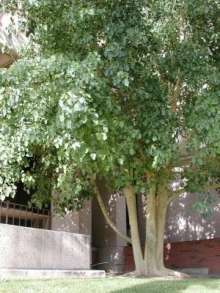
Scientific Name: Ficus petiolaris | Common Name: rock fig | Geographic Origin: Baja California | Botanical Family: Moraceae
Campus Location: Southwest side of the Main Library
Accession # : 3137
Special Status: Living Heritage Tree
Brief Description: The only one of its species on campus, and the biggest in Tucson, this tree was grown from seed (or seedling) collected in Mexico. It was cultured at UA Campus Ag Center and planted in the early 1980s by Warren Jones.
Brief Ethnobotany: This plant has numerous used in traditional medicinal to treat fever, ulcers, wounds, and fractures.
To learn more about this species, vist the species description page found here.
Available for Sponsorship: Yes
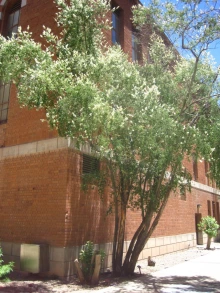
Scientific Name: Havardia pallens | Common Name: tenaza | Geographic Origin: Mexico | Botanical Family: Fabaceae
Campus Location: Magic alley – South of Old Chemistry
Accession # : 1566
Special Status: Heritage Tree removed for construction in 2023.
Brief Description: This tree was the largest of its species on campus. A Sonoran native, it wasthe biggest in Tucson, and quite possibly in the state of Arizona. It was planted by Warren Jones during the 1970's, it has thrived in the warm microclimate next to the Chemistry building. Since its original planting, others like it have been planted on campus, achieving similar size and grace across various microclimates.
Brief Ethnobotany: tenaza or huajillo is a member of the bean family, producing highly nutritious and edible pods.
To learn more about this species, vist the species description page found here.
Available for Sponsorship: No
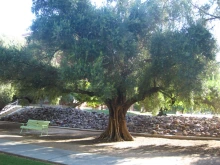
Scientific Name: Olea europaea | Common Name: olive | Geographic Origin: Middle East | Botanical Family: Oleaceae
Campus Location: Park Avenue and North Rogers Way
Accession # : Multiple
Special Status: Living Heritage Tree
Brief Description: All the olive trees on the western part of campus are designated university heritage trees. Any olive tree that has a special meaning for the donor may be adopted. The oldest ones are on the N. side of North Campus Drive and were planted by Prof. obert Forbes in the late 1800's. The trees were part of a variety trial for Forbes's investigation of agricultural crops from dry lands around the world, with potential for use in Tucson. In the early years of the 20th century, olives were planted along all walks in the Historic District on the west of campus.
Brief Ethnobotany: Olives, and olive oil are well known for their culinary uses and related health benefits as a monounsaturated fatty acid. There are also a range of documented uses for hair, cancer, fever, and high blood pressure. In addition to these benefits, the inhalation of Olea europaea pollen is one of the most important causes of allergic respiratory diseases in the Mediterranean basin.
To learn more about this species, vist the species description page found here.
Available for Sponsorship: Yes
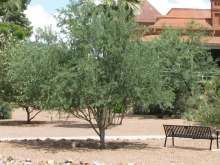
Scientific Name: Olneya tesota | Common Name: desert ironwood | Geographic Origin: Desert Soutwest | Botanical Family: Fabaceae
Family: Fabaceae
Campus Location: Southwest of Old Main
Accession # : 12755
Special Status: Living Heritage Tree
Brief Description: This slow growing desert species was planted as part of the Campus Arboretum dedication ceremony, in September 2002. The event marked the culmination of the four previous years' efforts toward establishing an arboretum and joining the American Association of Botanical Gardens and Arboreta. It is destined to become a long lived representative of the University's origins as the Land Grant Institution in the Sonoran Desert of the Arizona Territory.
To learn more about this species, vist the species description page found here.
Available for Sponsorship: No
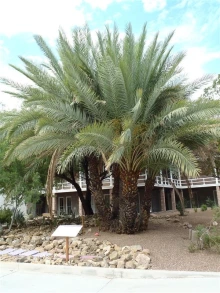
Scientific Name: Phoenix dactylifera | Common Name: true date palm | Geographic Origin: Middle East | Botanical Family: Areacaceae
Campus Location: East of Old Main
Accession # : 216
Special Status: Living Heritage Tree
Brief Description: This tree was given to the University in 1955 by students from Iraq. It honors Dr. Phillip Eckert, Dean of the UA College of Agriculture. At that time the University was collaborating (with the US Dept. of State and the US Dept. of Agriculture) to assist in the development of the Agricultural College of Iraq at Abu Ghraib, near Baghdad. This was one of the first such collaborations between a US university and a foreign government. Dr. Phillip Eckert was Dean of the College of Agriculture in 1952. He had responsibility for coordinating the project. To honor and thank him in 1955, Iraqi students planted a date palm from Iraq on campus. The tree still stands by Old Main. Recently his daughters, Susan Eckert and Karen Sanzone visited campus with Patricia and Hussam Urfali, (wife and son of of Hufdhi Urfali, one of the original Iraqi students). The 75 year old tree has an interpretive sign to honor Dr. Eckert and his efforts in establishing the Agricultural College of Iraq.
Brief Ethnobotany: The yellow orange to red dates are oblong and about 1.5 inches in length. These are harvested in late summer and early autumn. Ripe dates are rich in sugar, 60-80% of the contents. Ethnobotany: The word “date” comes from an Ancient Greek word “dáktulos”, meaning finger. The tree is cited 10 places in the Quran. Generally grown in arid regions with supplemental water, a single palm can produce in excess of 250 pounds of dates per season. Health Benefits: Dates contain tannins with antioxidants properties that are proven to have anti-inflammatory characteristics. Dates are also a great source of Vitamin A which helps with vision, and skin health, and protects from oral and lung cancer. Dates protect against age-related macular degeneration as a result of the high level of the carotenoid zea-xanthin.
To learn more about this species, vist the species description page found here.
Available for Sponsorship: Yes
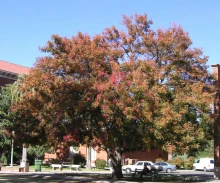
Scientific Name: Pistacia chinensis | Common Name: Chinese pistache | Geographic Origin: Asia | Botanical Family: Anacardiaceae
Campus Location: West of Communications / East of the Arizona State Museum
Accession # : 3833
Special Status: Living Heritage Tree
Brief Description: The largest and most vigorous of its species on campus. Located S, this elegant tree glows each autumn with copper leaves and red fruit. It has been a fixture in the Historic District of campus since the late 1960's. Designated a Great Tree of Arizona, 2004.
Brief Ethnobotany: Twigs of Pistacia chinensis, were found to have two novel ingredients with estrogen-like activity. It is a relative of many commercially cultivated food plants including cashews, and mangos. It is also a cousin to poison ivy,
To learn more about this species, vist the species description page found here.
Available for Sponsorship: No
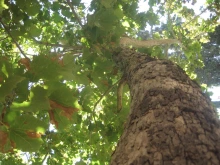
Scientific Name: Platanus occidentalis | Common Name: American sycamore | Geographic Origin: Eastern US | Botanical Family: Platanaceae
Campus Location: East of the Kuiper Sciences Building
Accession # : 8709
Special Status: Living Heritage Tree
Brief Description: Called the "Moon Tree", this sycamore was grown from seed that went to the moon with the Apollo 14 mission in 1971. The tree's value and unique history is explained on a plaque installed by the Arizona State Forester in 1976. See more about the Moon Trees at http://nssdc.gsfc.nasa.gov/planetary/lunar/moon_tree.html
Brief Ethnobotany: This monoecious plant has been used as a tonic and fever treatment. As a member of the Platanaceae, or sycamore family, this tree is related to many economically important plants used for their wood products and ornamental landscape value.
To learn more about this species, vist the species description page found here.
Available for Sponsorship: Yes

Scientific Name: Quercus suber | Common Name: cork oak | Geographic Origin: Mediterranean | Botanical Family: Fagaceae
Campus Location: South side of the Engineering Building
Accession # : 1319
Special Status: Living Heritage Tree
Brief Description: This specimen is the largest of its species on campus. Planted some time prior to 1940, Steve Fazio, former Professor of Plant Sciences, remembers showing his young children the tree in the late 1940’s. Alumni who were on campus in the 1960s remember using it as part of a fraternity initiation ceremony. Today students of botany, landscape architecture, ecology, and other sciences learn about the centuries-old technique of sustainably harvesting cork by peeling off the bark. Designated a Great Tree of Arizona in 2004.
Brief Ethnobotany: This tree is famously used for producing and harvesting cork.
To learn more about this species, vist the species description page found here.
Available for Sponsorship: No
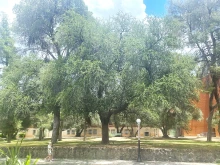
Scientific Name: Quercus virginiana | Common Name: southern live oak | Geographic Origin: Southeastern US | Botanical Family: Fagaaceae
Campus Location: South end of the Park Ave. Green Belt
Accession # : 1457
Special Status: Living Heritage Tree
Brief Description: This dark-leafed, spreading tree was planted by former Professor of Horticulture Steve Fazio around 1950. Steve tells how he planted several acorns in the Park Ave. Green Belt area, and this one remains. Undoubtedly, it is the largest southern live oak in Tucson. Designated a Great Tree of Arizona, spring 2002.
Brief Ethnobotany: This tree, in the Fagaceae, or beech and oak family, has traditional medical uses for dysentery, eye disorders and sores.
To learn more about this species, vist the species description page found here.
Available for Sponsorship: Yes
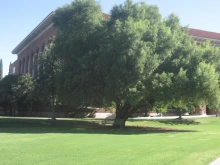
Scientific Name: Searsia lancea | Common Name: African sumac | Geographic Origin: Africa | Botanical Family: Anacardicaceae
Campus Location: Between Maricopa and Yuma Hall
Accession # : 6712
Special Status: Living Heritage Tree
Brief Description: The large stately tree between Maricopa and Yuma Hall was the first one planted in Tucson. The seeds were collected in North Pretoria, South Africa in 1919 by former President Homer Shantz. After germination in Chico, CA, two seedlings were transported to Arizona: one taken to Boyce Thompson SW Arboretum in Superior, AZ, and the other eventually planted on the UA campus in 1928. This specimen was designated a Great Tree of Arizona in 2003.
To learn more about this species, vist the species description page found here.
Available for Sponsorship: Yes
Support Heritage Tree Care, Tree Planting and Tree-Focused Education
To ensure preservation of individual trees and the greater development of campus greenspaces for education and public benefit, Heritage trees can be adopted. To recognize sizable gifts to the Campus Arboretum, a bronze heritage plaque will be installed with a custom inscription by the donor. Funds will be invested to support expert care for these extraordinary treasures and for educational programs promoting stewardship and conservation of trees for arid climates.Visit the Sponsorship and Giving Tab to learn more.

